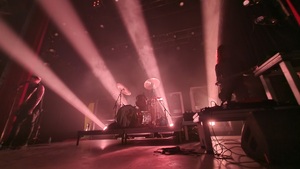“japan_logo”
Japansportation
Lord Gregory Monkey
When I was in high school, I saw this shirt in a catalogue with a picture of Godzilla eating a train while crushing a city and a caption that read, “What’s your excuse for not using public transportation?” I wanted to get the shirt, but then realized that I was a total hypocrite since I refused to ride the bus to and from school. That wasn’t cool, man. I had to drive my father’s shit-brown 1978 Chevy Malibu Supreme station wagon. That was cool!
But now the shirt and its message take on new meaning for me. Living in Japan almost forces one to utilize public transportation. Cars are too damn expensive here, and there is no reason not to use PT when you live in a place that has an excellent time and cost efficient system. The one set up in Japan is amazing, and I have no excuses (or other options), so I use it. Besides, I don’t want to be the bastard blamed for opening a can of atomic lizard on the islands.
Not everyone is using PT here in Japan; there are a bundle of privileged foes who have cars. A car is regarded as a real prestige symbol here – especially a car from the United States! People adore and love their cars, keeping them immaculately clean, but there is almost no reason to use a car. Driving a car can frequently take longer to reach a destination than using the trains, subways, and buses. The roads in Japan are not built for heavy traffic. With the exception of highways, most routes in Japan seem to have been built for scooters (a much more popular form of transport than cars) and pedestrians. These are one-lane roads that don’t have room for two cars to pass each other, but just in case they can: cars’ side view mirrors have motors built in them so that with the touch of a button they will fold into the doors to avoid being knocked off by a passing machine. Gasoline prices are mighty high in Japan, and every few years your car must go through rigorous inspections and the owner must pay gigantic taxes and fines to keep their vehicle afloat. It is not uncommon to see cars less then ten years old sitting in abandonment or in a junkyard.
“japan_quote”
But like I said, I have no car and I have no excuse, so I ride the train. When my little bike cannot get me to where I need to go, I hop on down to my local Japan Rail (JR) station and pay about a dollar fifty and in less than ten minutes it’ll get me to a destination that would take a car about a half hour.
In Japan, public transportation breaks down into a few simple modes. You’ve got your boats and ferries on the coasts, buses all over the damn place, subways in the big cities, super expensive taxis, and trains everywhere possibly imaginable. I’m landlocked, so I have little experience with aquatic transport, but I know there’s everything from pokey ferry boats to speedy hydrofoils. Taxis, subways, and buses run the same as they do anywhere else in the world, although there are some bus stops in the middle of rice paddies.
Trains are a bit more interesting. In Japan the largest train company is the semi-privatized national Japan Rail (JR) line, which has divisions in each section of Japan. JR is also the company who owns and runs the slick and speedy “bullet trains” or Shinkansen. There are also a slew of private lines providing local and regional services.
Trains are by far the most popular and widely used form of transportation in Japan. For a country whose combined land size is a little bit smaller than California, it is amazing to think that the JR line alone has over 20,000 kilometers of running tracks and performs over 20,000 services daily! Japan is a land covered with tracks. The local trains in my area run through rice fields, fish farms, industrial factories, and people’s backyards. It is not always the prettiest view, but in some parts of the country the trains will take you through postcard quality scenery. Train stations are frequently massive hubs of happenings. There are usually oodles of [noodle] restaurants and department stores and bars and entertainment districts surrounding a large station. In some smaller towns, the train station may serve as the bank and post office as well. One thing that I find interesting about the train system in Japan is the effect it has had on nightlife. Since the trains stop running around midnight, almost every bar and club and restaurant in the country shuts down at about that time. Most people need to catch that last train to make it home and so everything shuts down early. This isn’t true for the large entertainment districts in the big cities, which stay up all night, but even on the weekends most places in Japan put the lights out at midnight. I’ve had to personally adjust my drinking so that by 9PM I’m good and drunk.
During rush hours the trains become so packed with bodies that “sardine canned” doesn’t do descriptive justice. It’s more like vacuum packing coffee into a train car: as soon as the doors open you can here this SWOOSH and more people than you thought humanly possible come flying out of the train. In big cities like Tokyo and Osaka there are porters on the platforms whose job is to actually push people into the car. They are responsible for packing as many people into a car as there are pork products in a can of SPAM.
Your chances of a getting a seat on a train during rush hour are zero, but your chances of getting molested are high. One of the first things women on my program were taught to say was the word “Chikan,” which means pervert. Just in case a wandering hand on a crowded train finds its way to your breast or ass you’d better be ready to scream this word. Two good things are supposed to happen next: 1) the offending appendage will disappear; 2) everyone will get the hell out of your way and you’ll get a little breathing room. Apparently this crowded molestation is a frequent occurrence, especially with foreign women and with Japanese schoolgirls in uniform. Some of my high school students have told me about it happening to them and as a result they detest PT and want their own cars.
When it comes to speed, it looks as if France and Japan are constantly fighting to see who has the fastest trains. But the fastest train in the world belongs to the US. Yes, the United States produced the world’s fastest “rail vehicle,” an “unmanned rocket sled” tested in 1982 at White Sands Missile Test Base was clocked at 9,851 km/h, or Mach 8 (according to Lonely Planet). While France has the fastest conventional train in the world, JR’s Shinkansen trains have the fastest running times between stops. The magnetic levitation trains being tested in Japan are sick bastards with top speeds kickin’ over 531 km/h (332 mph)! Unfortunately you gotta pay some big yennies to ride the Shinkansen, so I only hop on it when I’ve got a long trip ahead of me. It is an incredibly comfortable train ride though, with huge, reclining seats, plenty of leg room and the train cars are somehow welded together so there is no noise or clanking as you zip along the tracks at 300 km/h. The Shinkansen was nicknamed the bullet train because of its killer speeds and its nose’s resemblance of (dah) a bullet. The newest Shinkansen train on the tracks is the JR West and this sonofabitch looks incredibly fierce. Its nose is elongated for a good 15 or twenty feet and comes to a sharp point and the conductors peer out of a crazy lookin’ black glass bubble. This train looks like it could fly, and if you put wings on it, it would.
Sometimes, I unfortunately do miss the last train, and then I have to find a way home, which can be very difficult and costly. I used to just crash at the nearest friend’s apartment, but lately when this happens, I go down to the one of the many rotating sushi bars before they lock up and I get my fill of shrimp sashimi. Then I move a bunch of plates out of the way, get on the conveyor belt and let the swirling sea of raw foods take me from one side of the room to the other. If I suck down enough Chinese deer penis wine I might actually get teleported from one blue collar rotating sushi joint to another closer to home! But, this form of transportation isn’t always effective.
Perhaps the only thing I miss about not having a car these days is the personal freedom that I used to have in which I could go anywhere at anytime that I wanted. But I rarely feel any grief from this absence. I feel good about letting the Earth breathe some slightly fresher air now that my ass isn’t further polluting it with exhaust from el carrito. Hopefully, wherever I move to after Japan will also have a decent PT system so that I can use it. However I doubt if any city will be able to match Japan’s system though… for instance, who’s gonna grab my ass? ◼












